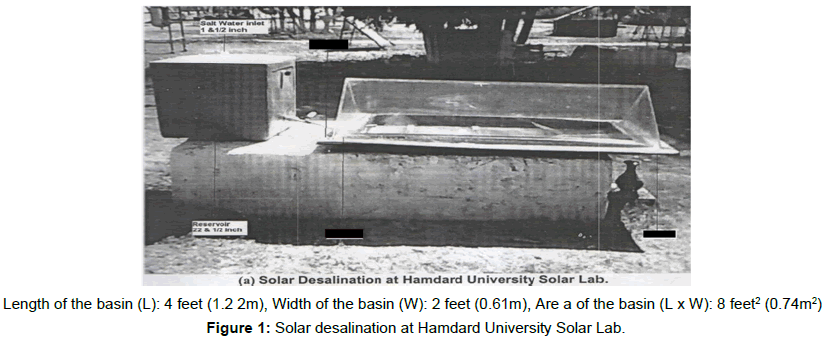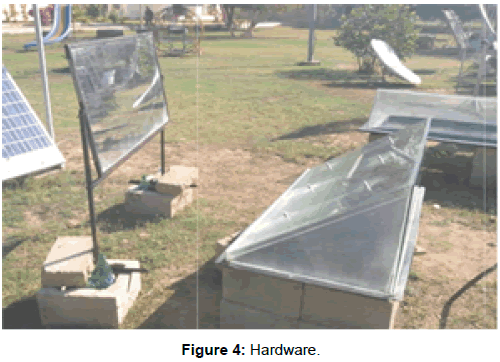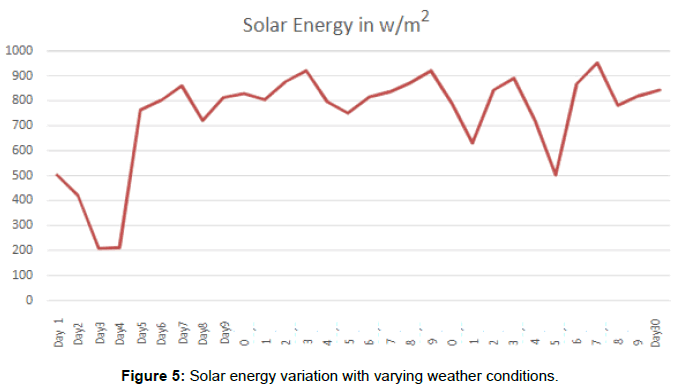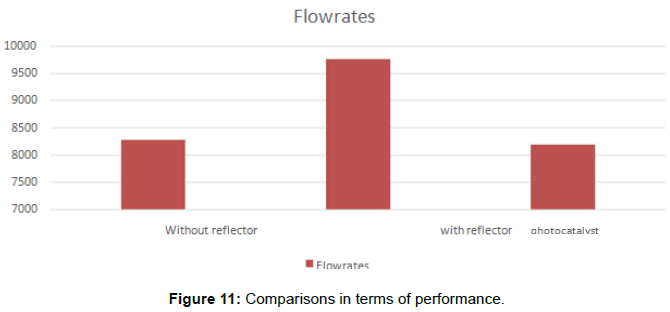Comparative Performance Analysis of Rectangular Shaped Solar Collector Basin with Reflector and Photo Catalyst
Received: 26-Oct-2017 / Accepted Date: 30-Oct-2017 / Published Date: 11-Nov-2017 DOI: 10.4172/2576-1463.1000176
Abstract
One of the basic requirements for every human being is the availability of clean drinking water, but about 1.1 billion people in the world lacked pure drinking water. Thfere several types of water purification processes used worldwide such as filtration, reverse osmosis, ultraviolet radiation, carbon absorption, but distillation and boiling is considered to be the most reliable among these process. In areas where water resources or tap water is not suitable for drinking without boiling or chemical treatment Water purification, such as distillation, plays an important role in providing clean drinking water. Distillation is the common method usually seen in nature in which the water on earth is heated by sun and then converted into a vapor (evaporation) and rises, leaving behind contaminants, to form clouds. The vapor converts back to water after it cools when the temperature in the upper atmosphere drops.
Water is essential for life. The origin and continuance of mankind is based on water. Developing countries face a significant problem in the supply of drinking water. With the increasing population and industrial growth and agricultural activities causes depletion of many fresh water resources due to rapid increase in need for energy and to overcome environmental concerns much attention is focused on renewable energy resources. Solar distillation is one of the non-conventional methods to desalinate brackish water or sea water. This work focuses on an experimental investigation by comparing the performance of two solar stills such as rectangular shape and basin shape solar still, with photo catalyst and reflector base solar still. The comparative performance study is analyzed for the same weather conditions with different design parameters and some important conclusions were assigned.
Keywords: Drinking water; Photo catalyst; Rectangular shape basin; Weather conditions
Introduction
Water, the most essential element of life, is a gift from nature and it has vital role in the advancement of economy and for the welfare of a nation. All over the world the most important problem faced by under developed and developing countries is the un availability of drinking water as today around the world there is a severe shortage of fresh water. Increase in the water shortage is mainly caused by worldwide drought and desertification. The population grows day by day, and it is estimated that the global population will reach 8 billion by 2025 and thus the usage of water per capita increases and its availability will drop, and with this estimation it is assumed that two thirds of the population will lack sufficient fresh water by 2025 [1-3].
Day by day demand of fresh water is increasing & it is finite on earth. Fresh water resources are depleting due to the rapid increase of industrial and agricultural activities and the pollution caused by them. Therefore, there is an essential and earnest requisite to get fresh water from the saline/brackish water present on or inside the earth [3]. Almost three quarter of earth is covered with water however 97% of the water is present in oceans and only 3% of the water resources are portable and less than 1% fresh water is within reach of humans. This small fraction (ground water, lakes and rivers) is believed to be adequate to support life and vegetation. About 25% of the world does not have availability of good quality and quantity of fresh water and more than 80 countries face severe water problem [3]. Now a day’s pollution caused by industrial effluent in ground and surface water leads to a very little supply of fresh water in many big cities around the world.
A remote and arid region depends mostly on underground water for drinking. Under ground water found in remote and arid areas have salin ity and is not considered as fresh water and is not fi t for drinking, this water is called brackish water.
The salinity of brackish water varies with locations. If the water found in remote areea is brackish then fresh water has to be either transported for long distances or connected with an expensive distribution water network at extremely high co st for a small population [3]. Excess brackishness causes the problem of taste, stomach problems and la xative effects. According to World Health Organizzation (WHO), the permissible limit of salinity in water is 500 ppm but most of the water available on earth has the salinity up to 10,000 ppm. Purification of water is accomplished by several desalination me thods like reverse osmosis, electro dialysis, vapor co mpression, multistage flash distillation multiple-effect distillation and solar distillation [4].
In remote areas of low population densities solar energy will be more economical the n the use of fossil fuel because remote areas have abundant solar energy and low rain fall [5,6]. In water scare and drought areas like Africa and Asia solar stills can be a highly reliable source to provide us with the necessary daily amount of drinking water. Solar stills are maintenance free as they do not have any moving parts.
One of the measure problems of solar still is their low productivity but this can be overcome by using different techniques. In this context, distilled water evaporation rate is improved by making solar still basin on Copper sheet instead of Galvanized Iron sheet. The rate of heat transfer to water in the still made up of Copper is more and hence the increase in efficiency. The attempts are also made to increase the productivity of water by painting black coating inside the still basin made up of Copper sheet.
Fabrication Detail
Rectangular basin shaped solar still
Rectangular basin shaped solar still area of 8 feet2 (0.74 m2) is designed. The still was filled with the water a height of 0.05 m. The top of the system is covered by a glass with a height of 0.20 m at the middle. It is tightened using bolts provided at the surface with cushion supports. The bottom of the still is insulated using sawdust. The water storage basin of the still are constructed with dimension 1.22 m *0.61 m of mild steel. Water collection segment of dimension 0.10 m×0.05 m×0.075 m is provided at four sides of the basin walls. Outlet pipes are provided at two sides of the water collection segment. Water was poured to the basin by using the funnel through the inlet at outside the system [7]. The pictorial view of pyramid solar still is shown in Figure 1.
Basin shaped Photo catalyst & reflector based solar still
The basin of the solar still is made up of fiber which is black in color and used as a collector. A glass is also installed to make a still tightly packed due to chamber vacuum in order to get better evaporation (Figure 2).
Photocatalyst
The word photo catalyst is made up of two words photo and catalyst. Catalyst is the process in which a substance does not consume itself but modifies the rate of reaction.
Catalyst is the substance which increases the rate of reaction by reducing the activation energy. A reaction which uses light to activate a substance which modifies the rate of reaction is called photo catalyst. It modifies the rate of chemical reaction using light irradiation (Figures 3 and 4).
Methodology
rectangular shaped solar still and photo catalyst& reflector based solar still installed at the solar energy laboratory, Hamdard University of engineering science & technology Karachi were used to record measurements The variations of water temperatures and glass temperatures of the s till as well as the productivity with respect to time are recorded. Calibrated meters were used to carry out measurements.
Pyrometer is used to record solar radiations. The hourly productivity of the fresh water is collected through a measuring jar. The daily productivity is obtained as summation of day and night productivity.
Result
This graph (Figure 5) shows the behavior of solar energy which was recorded at Hamdard University
Temperature
The ambient temperature was recorded at Hamdard University (Figure 6).
Wind
This wind data was collected at Hamdard University (Figure 7).
Distilled Water without reflector
The reading taken by our hardware without using reflector. This reading is of 22 days.
The curve show rate of distilled water & variation because of sunlight not properly available on different days (Figure 8).
Distilled water with reflector
The reading taken out by hardware using with reflector to increase the output of product.
The purpose of using reflector finally achieved. The output of product has increased (Figure 9).
Distilled water using photocatalyst
The curve show the quality of water increases with the use of photocatalyst.
The quality testing was done in lab of PCSIR (Figure 10).
Comparisons in terms of performance
This comparison among without, with reflector & photo catalyst.
The output graph of product using different techniques show that output increased (Figure 11).
Comparison between university hardware & our hardware
The result shows that our designed hardware gives more output than existing harrdware. The readings were taken on the same day with same meteorological conditions (Figures 12 and 13).
Water quality test results
Sample: Hamdardd University
Test center: PCSIR Laboratories (Table 1a).
| Parameters | Tap water | Distilled Water | With Photo catalyst | International standards |
|---|---|---|---|---|
| PH | 8.3 | 7.3 | 7.18 | 6.5 - 8.5 |
| TDS | 2760 ppm | 967 ppm | 867 ppm | |
| Total Hardness | 470 mg/l | 200 mg/l | 182 mg/l | - |
| Turbidity | 4.8 NTU | 3.2 NTU | 4.6 NTU |
Table 1(a): Water quality test results.
Sample: Seaview water
Test date: 9/12/15
Test center: PCSIR laboratories (Table 1b).
| Parameters | Sea water | Distilled Water | With Photo catalyst | International standards |
|---|---|---|---|---|
| PH | 9.1 | 7.8 | 7.6 | 6.5-8.5 |
| TDS | 3021 ppm | 979 ppm | 871 ppm | |
| Total Hardness | 790 mg/l | 380 mg/l | 231 mg/l | - |
| Turbidity | 7 NTU | 4.7 NTU | 4.8 NTU |
Table 1(b): Water quality test results.
The result shows that our designed hardware gives more output than existing hardware. The readings were taken on the same day with same meteorological conditions [8-13].
Discussion
The comparison between rectangular and basin shaped solar still was done to investigate better performance in distillate yield. The system was operated continuously for several clear sky days. The influence of climatic conditions and solar radiation, on the system in production of distillate yield was investigated. Figure 5 represents the solar intensity measurement. The minimum radiation that was recorded was 450 w/m2 and maximum was found to be 1099.7 w/m2. The peak value during the study was recorded during 2 pm to 1 pm for both the experiments. The temperature variation at different parts of the still during the operation with respect to time is shown in Figure 6. When the temperature increases the solar radiation transmitted through the glass cover heating up the basin water. Water uses the one part of thermal energy and the other part of energy is transferred to insulation material under the basin material. water temperature is higher than the basin temperature At the beginning. But in the evening, when the solar radiation decreases, water and air inside the still starts to cool down and water temperature curve falls down.
As the ambient temperature decreases with time the temperatures of basin liner and other elements of the still slowly decreases. This causes a significant difference between basin and insulation temperatures during the night period. Fresh water is produced by a small quantity of heat gained by the insulation in this period which keeps the basin water temperature high due to insulation made by low thermal conductivity. This causes an enhancement of the still productivity, especially during the night period. Solar intensity has a major effect on the performance of the solar stills. A shadow effect creates a small amount of shadow to fall over the water surface during the morning time as well as in the evening time. This type of drawbacks is fully rectified by reducing the height of the basin as well as hemispherical shape top cover. Thus the shadow effect does not affect the rise in water temperature. Figure 13a shows the variation of efficiency with respect to time. Hemispherical solar still has a maximum efficiency of 32.02% and pyramid solar still has an efficiency of 26.59%. The yield rates of the two systems are shown in Figure 13b and 13c. It reveals that the productivity is more for hemispherical solar still. Because this type of still has a peculiar advantage such as, it receives the radiation from all the sides of the still. But in the pyramid solar still, the radiation may scattered due to the top edge.
Conclusion
Comparative study was carried out of rectangular basin shaped solar collector with basin shaped photo catalyst and reflector based solar still. The readings were recorded at different atmospheric conditions throughout the day of the month of December. The following parameters were calculated throughout the day Wind, solar, temperature, water quality and quantity was also measured throughout the day. The readings were taken for 22 days in the month of December. The readings were recorded with reflector and without reflector. The readings indicated that the overall performance of basin shaped photo catalyst and reflector based solar still was better than the rectangular shaped basin solar collector. It was also observed that solar radiation affect the overall performance of solar collectors. To improve the quality and quantity of distilled water, the solar still was designed with reflector and addition of photo catalyst, the reflector increased the temperature of basin which caused rapid evaporation & condensation, and enhance the rate of distillation and quality of water. Thus result shows that solar still with reflector & photo catalyst increases the quality & quantity of distilled water. It is observed that temperature; solar energy & wind energy affects the rate of distillation and the performance of solar still. To reduce these issues solar still with reflector & photo catalyst become appropriate solution for tropical countries like Pakistan which has large period of constant weather.
A remote and arid region depends mostly on underground water for drinking. Under ground water found in remote and arid areas have salin ity and is not considered as fresh water and is not fit for drinking, this water is called brackish water.
The salinity of brackish water varies with locations. If the water found in remote areea is brackish then fresh water has to be either transported for long distances or connected with an expensive distribution water network at extremely high cost for a small population [4]. Excess brackishness causes the problem of taste, stomach problems and la xative effects. According to World Health Organizzation (WHO), the permissible limit of salinity in wate r is 500 ppm but most of the water available on earth has the salinity up to 10,000 ppm. Purification of water is accomplished by several desalination me thods like reverse osmosis, electro dialysis, vapor co mpression, multistage flash distillation multiple-effect distillation and solar distillation [5].
In remote areas of low population densities solar energy will be more economical the n the use of fossil fuel because remote areas have abu ndant solar energy and low rain fall. In water scare and drought areas like Africa and Asia solar stills can be a highly reliable source to provide us with the necessary daily amount of drinking water. Solar stills are maintenance free as they do not have any moving parts.
One of the measure problems of solar still is their low productivity but this can be o vercome by using different techniques. In this contex t, distilled water evaporation rate is improved by making solar still basin on Copper sheet instead of G alvanized Iron sheet. The rate of heat transfer to water in the still made up of Copper is more and hence t he increase in efficiency. The attempts are also ma de to increase the productivity of water by painting black coating inside the still basin made up of Copper sheet.
References
- Khan N (2009) Energy resources & utilization (1st Edn) royal publishers Karachi, Pakistan.
- Himangshu B (2017) Efficiency improvement of flat plate solar collector using reflector. Energy Reports 3: 119-123.
- Hemant BP, Umang RS, Asthana GS (2016) Performance analysis of active solar still with ethp solar collator attached as natural convection. International Journal on Recent and Innovation Trends in Computing and Communication 2: 958-966.
- Michel N (2017) Data Analysis of the Energy Performance of Large Scale Solar Collectors for District Heating.
- Energisystem: kompletterande information, Technical Water Resource Management.
- Vipin BN, Gorle RD (2016) Performance Analysis of Flat Plate Solar Water Collector using Trapezoidal shape and Semi-circular Tubes: A Review. International Research Journal of Engineering and Technology 3: 2012-2015.
Citation: Buksh K, Ali S, Raza A (2017) Comparative Performance Analysis of Rectangular Shaped Solar Collector Basin with Reflector and Photo Catalyst. Innov Ener Res 6: 176. DOI: 10.4172/2576-1463.1000176
Copyright: ©2017 Buksh K, et al. This is an open-access article distributed under the terms of the Creative Commons Attribution License, which permits unrestricted use, distribution, and reproduction in any medium, provided the original author and source are credited.
Select your language of interest to view the total content in your interested language
Share This Article
Recommended Journals
Open Access Journals
Article Tools
Article Usage
- Total views: 6267
- [From(publication date): 0-2017 - Dec 19, 2025]
- Breakdown by view type
- HTML page views: 5305
- PDF downloads: 962















